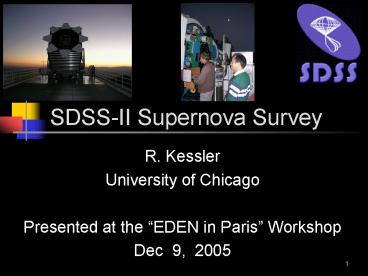SDSSII Supernova Survey PowerPoint PPT Presentation
1 / 22
Title: SDSSII Supernova Survey
1
SDSS-II Supernova Survey
- R. Kessler
- University of Chicago
- Presented at the EDEN in Paris Workshop
- Dec 9, 2005
2
SDSS II Institutions and Supernova Collaboration
SDSS II Supernova Survey Institutional
Members American Museum of Natural History,
Astrophysical Institute Potsdam, Cambridge
University, University of Chicago, Fermi
National Accelerator Laboratory, Japan
Participation Group, Johns Hopkins University,
Joint Institute for Nuclear Astrophysics,
Stanford KIPAC, Korean Scientist Group,
LAMOST Los Alamos National Laboratory, Max-
Planck Institute for Astrophysics/Garching New
Mexico State University, Ohio State University,
Princeton University US Naval Observatory,
University of Washington. SDSS Supernova Program
Includes Collaborators from Apache Point
Observatory, Space Telescope Science Institute,
Penn State, Rochester Institute of Technology,
South African Astronomical Observatory, University
of Portsmouth, University of Texas, University
of Goettingen, University of Munich
3
Science
- Explore Hubble diagram in sparsely populated
redshift region (lt0.1 - 0.4) goal is 200
well-measured SN1a lightcurves in 3 years. - Complement deeper surveys.
- Study systematics of dL from SN1a.
(with unique low-z to mid-z sample) - u-band templates for zgt1 surveys.
- Collect spectra to study K-corrections.
- Collect SN types Ib,Ic,II (and peculiar/rare).
- Measure SN rates vs. z.
4
Science
- Explore Hubble diagram in sparsely populated
redshift region (lt0.1 - 0.4) goal is 200
well-measured SN1a lightcurves in 3 years. - Complement deeper surveys.
- Study systematics of dL from SN1a.
(with unique low-z to mid-z sample) - u-band templates for zgt1 surveys.
- Collect spectra to study K-corrections.
- Collect SN types Ib,Ic,II (and peculiar/rare).
- Measure SN rates vs. z.
5
Overview of Survey
(Sep 1 - Nov 30, 2005, 2006, 2007)
- Alternate each night between 82N
and 82S (300 sq deg coverage) - Image in drift-scan mode
2.50
30 2k x 2k CCDs, 0.4 resolution
1200 (20 hr lt RA lt 4 hr)
6
Overview of Survey
(Sep 1 - Nov 30, 2005, 2006, 2007)
just finished 1st season gt subject of this talk
- Alternate each night between 82N
and 82S (300 sq deg coverage) - Image in drift-scan mode
2.50
1200 (20 hr lt RA lt 4 hr)
7
The SDSS 2.5m Telescope
- 2.5m primary
- ugriz filters
- 1 minute exposures
- Location Apache Point Observatory in New
Mexico (3000 m altitude) - DA was upgraded in summer 2005
(includes data ? disk
instead of tape) - Substantial non-SDSS resources
(later in talk)
8
Data Reduction for Survey
- Data are reduced and image-subtracted
- at APO using ten dual-CPU servers with
8 Tb disk space. - Subtractions in g,r,i
- Full night processed in lt 20 hrs
- Results copied to FNAL for human scanning
- u,z forced photometry done next day on SN
candidates found in scanning gri - (apply u-g cut to distiguish Type I, II)
9
Scan Example
To appear on scan- page requires the difference
image for at least two filters to have
sig/noise gt 3 and to be within 0.6 .
10
Lightcurve Fits
- Each SN scan-tag gets a mult-band lightcurve fit
to Ia, Ibc, II - crucial for selecting objects
- for spectro follow up
z 0.045
11
Lightcurve Fits
- Each SN scan-tag gets a mult-band lightcurve fit
to Ia, Ibc, II - crucial for selecting objects
- for spectro follow up
z 0.12
z 0.41
12
Follow-up spectra from HET, Subaru, WHT, ARC
3.5m, MDM, Keck
13
2005 Data Overview (no cuts)
14
2005 Imaging Overview
- 1370 SN1a images with 2.5m gt 10
epochs per SN lightcurve. - 200 SNe images with non-2.5m to cover bad
weather, faint epochs (mag gt22) and
post-season follow-up
UH88, NMSU 1m, MDM and occasional ARC3.5, VATT,
LT, WIYN
15
2005 Spectra Overview
- 200 total SN spectra
HET, Subaru, WHT, ARC 3.5m, MDM, Keck
16
First imaging epoch vs. redshift
No cuts
(2005 sample)
17
Fakes
- Fake SNe are inserted into data to track
efficiency of software pipelines and human
scanning. - Needed to measure SN rates.
- Keeps scanners alert.
- Still no spectrum requested for a fake !!!
18
Efficiency for Fake Supernova
obtained spectrum after lightcurve fit/selecti
on (in progress)
at least one opportunity to scan from software
at least one SN tag from human
19
Potential for Combining SN Programs
SNLS residuals
20
Potential for Combining SN Programs
SNLS residuals
21
Potential for Combining SN Programs
30-40 low z (1 of 3 years)
SNLS residuals
45 non-SNLS SNe at low z
22
Summary
- Encouraging SN1a yield in 1st year
- Next year plans include
- ? reduce human scanning
- ? increased follow-up resources
- ? in-situ measure of lightcurve selection eff
- ? improve cross-calibration between
- SDSS 2.5m and other
- telescopes/programs

